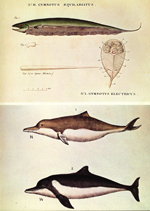Meeting 9 • 04 February 2014
|
Version: |
|
picture of the week |
|
|
|
mini-text of the week (start): "In Calabozo, in the middle of the llanos, we found an electric machine with great discs, electrophori, batteries and electrometers…"Humboldt, "Personal Narrative", from Jaguars and Electric Eels, ed. & trans. Wilson, pp. 57-8, 62 (read more) |
|
•√ (5') Thought-bite of last week (species differentiation and hypotheses) and last Sunday's folk holiday: ground hogs, marsupials, and the difference between Old World and New World creatures - including the philosophical & theological implications. This week's thought-bite: "Nature red in tooth and claw"; relation between human beings and Nature; what are the many meanings and applications (scientific or otherwise) of "change", "evolve", "evolution"? Leftover from last meeting: cladistic |
|
•√ (15') Billions of burgers, zettabytes of data, specialization of knowledge, and critical thinking/ reckoning Partner activity: How many burgers can we get from 100,000 beeves? Followed by obituary of Fred Turner and mention of an article about explosion of quantity of available data (and how to store it). SINQing the Humboldt canoe: 1) as material for discussion of curriculum: for math: age-appropriate activities; "spiral" syllabus; calculus?! AP?! Which other subject areas did we address / could be addressed? 2) food for thought: How do you know where you learned X? How do you know that what you learned is really true? How/When did you learn how to learn? We never answered the question, So what could that boat hold? importance of DATA (for Humboldt, for us; about Humboldt); example: how many position measurements did H make in a day? How many other measurements? Sources of errors in collecting and using data. Example: detecting non-solar planets Some data-rich docs we can't spend much time on (but could be the subject of projects): the full narrative; econ of Mexico; later views of AvH: was he too data-driven to see the Big Picture. Review and expansion of quantification activities, with application to food. A story that includes a story problem: How do nursing mothers do it? Rough calculation vs. precise calculation. Relation to food and energy needs of explorers. What did Lewis & Clark and the "Party of Discovery" Eat? (some other time: what ate them). How does that compare to your diet? How is nutritional research conducted - how do we get, so to speak, a window into the stomach? see book review candidate Catching Fire: How Cooking Made Us Human |
|
•+ (10') How people back then became scientists (matter of class, money, educational system, sex; earlier words for "science" and "scientist", since "scientist" wasn't used in its modern sense until the mid-19th Century; example of two British geologists; caution about "presentism" (projecting our world onto the past). Check question: when did astronomy and astrology become pursuits that were distinct from each other? |
|
•√ (10') Review of "Standards/ My Education" writing assignment: example of preK reading assessment. Small groups discuss own experiences. So how could the standards descriptions help you get a job? What did Humboldt "major" in, how did that help him "get a job", and how (much) did he plan his career? |
|
•+√(20') Activation of book review assignment: So now they're / we're / you're on board. We're just getting into the systematic discussion of sustainable environmentalism. We're finishing the basic reading (have you?), and now need to branch out for more reading. about majors and tacit knowledge; specifications, examples of book, books you can take with you today, list of books you can choose from later; examples of high-level book reviews (here: WBF, Jaynes, Origin of Consciousness in the Breakdown of the Bicameral Mind - but written when I was very young); recommendations for some special topics: women in Humboldt's time; religion and science; books on the list that I don't have copies of (use library, etc.). End of meeting: find a book, if you want one today, and sign it out; more chances next meeting |
|
•N √(05') Looking further ahead (projects, etc.): presentation (continuation) about educational standards and their parts in the course: 1) evaluating own education; 2) helping others to learn - how standards are used to develop curriculum (curricula?) and learning activities. Example of source of lesson plans; article (H0152) "School Gardens Blooming Teach Lessons On Nutrition, Environment, Science, Teamwork". This is preparation for assignments about species description and group projects. Next meeting: triangulation, including hands-on measurements of distances, heights, etc.; activiation of mid-term exam. Later: what it's like to read Darwin; Humboldt-named species; forming teams and scoping out projects (ideas for group projects); the iconic graphic of Chimborazo; 5) apps Humboldt would have liked; what shall we do with (to??) the people who haven't revealed their interests and strengths and don't get "on board" when they're needed? Start reading Stegner book |
|
•N (05') if time: some more apps |
|
(0') Use your computer/ smartphone map links and applications to trace AvH's route in South America, starting with his travel up the Orinoco and down the Amazon. See Helferich, p. 52 map, but be aware that some place names have been changed over time. looking ahead: presentation of project ideas (just the ideas, not fin |
